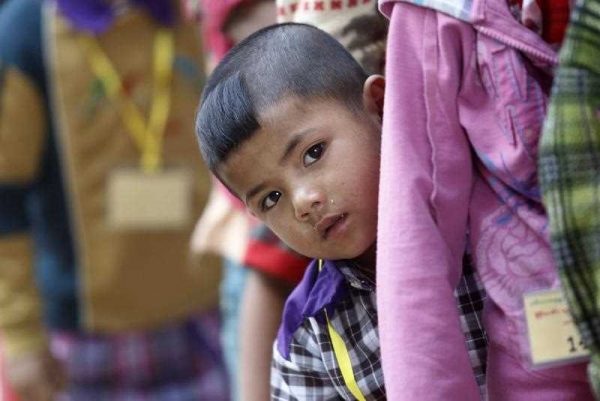Paradoxically, this coincides with a setback for the country’s ethnic minorities and their struggle for autonomous status. Myanmar’s ethnic minority organisations now face a double marginalisation, militarily as well as politically. It is a new era for Myanmar, but there is trouble ahead for ethnic minorities.
There are two main tiers in Myanmar’s peace process. The first is the process of negotiations between the government and the many ethnic armed groups. The second tier is a wider process of including ethnic minorities in political decision-making at the Union, state and regional levels. The success of the first tier is tremendously important for the second.
After five years of negotiations, a general agreement was reached on the content of a National Ceasefire Accord (NCA). The agreement signed on 15 October 2015 was meant to be applied nationwide, and most of the country’s ethnic armed groups took part in its negotiation. But due to disagreements between the Myanmar armed forces (Tatmadaw) and some of the ethnic armed organisations over the inclusion of additional armed groups, only eight armed groups decided to sign. Fighting has continued in the north and the northeast.
The NLD-led government may now get a chance to put its own stamp on the negotiations. But there are two remaining obstacles. The Tatmadaw is unlikely to allow the new government to make any further concessions to the ethnic armed groups. And the process so far has left these groups with little sense of achievement; they may not see much gain from a ceasefire. Local distrust of the Tatmadaw has grown instead of diminished in the areas where fighting has continued, and a rift has emerged between signatory and non-signatory groups.
This division and marginalisation of the ethnic armed groups has coincided with a devastating political defeat for the ethnic minority parties in the November 2015 elections, leaving many ethnic minorities with little or no representation in the country’s political institutions. Ethnic minorities fear being sidelined by the Bamar-oriented infighting between the NLD and the military.
Ethnic minority parties secured only 55 of the 498 elected seats in the Union Parliament. Most of these were won by the Arakan National Party and the Shan Nationalities League for Democracy. With the exception of Rakhine and Shan State, the ethnic minority parties also performed poorly in the state parliament elections.
There are three main reasons for their poor performance. The foremost is the extraordinary nature of this particular election, which most people viewed as a referendum for or against military rule.
Second, competition between political parties seeking to represent the same ethnic group proved to be divisive, though even the combined votes for the various ethnic parties would not have been enough to beat the NLD in most places. Only seven more seats in the Union Parliament and nine in the state parliaments would have gone to ethnic minority parties if they had managed to unite. Still, the pre-election merger of the two main Rakhine parties into the Arakan National Party certainly contributed to its success. Similar mergers in other states may have further enhanced ethnic minority representation.
Third, the first-past-the-post electoral system favoured the NLD as the largest party. With 57 per cent of the votes the NLD received 79 per cent of the elected seats in the Union Parliament — that is 57 per cent of the elected and appointed seats combined. Under the 2008 constitution, the military appoints 25 per cent of the Union and all state and regional assemblies.
It would be unwise to change to a system of proportional representation or a hybrid system, while retaining the 2008 framework, as that would disproportionally favour the military and the Union Solidarity and Development Party (USDP). Under the current system the USDP received 28 per cent of the popular votes, but only 8 per cent of the elected seats. It is also unlikely that the NLD, which now controls Myanmar’s legislative process, would want to change to a system that is less favourable for them.
Perhaps the only way that the electoral system might change in the foreseeable future is through a bargain where the NLD agrees to a more proportional system and the military agrees to give up its right to appoint 25 per cent of seats. This would be a significant step towards a genuine democracy, and would hopefully enhance the chance of ethnic minority representation.
Electoral defeat means that already marginalised ethnic minorities are now underrepresented politically at a critical juncture in Myanmar’s democratic transition. For the current peace process to succeed there must be channels through which ethnic minority organisations can express their grievances and work towards reforms. This is important in order to build trust between the Bamar majority and the ethnic minorities, and also to show the ethnic armed groups that there is space for ethnic minorities to contribute politically to the decision-making process. Any further marginalisation of ethnic minorities at the political level is likely to be detrimental to the peace process.
Marte Nilsen is a senior researcher and Stein Tønnesson a research professor at the Peace Research Institute Oslo (PRIO).


Per other posts, 40% of the population on Myanmar are not of the majority Bamar ethnic group. With this sizeable a percentage of the population being underrepresented and at times violently suppressed by the Buddhist monks, for example, it is not surprising that there has been armed conflict. Hopefully, the new government led by the NLD can find ways to be more respectful and inclusive of these groups.
Thanks for your comment, Richard. You are right. Democratisation is certainly no quick fix to end ethnic conflicts, unfortunately. So let us hope the NLD will work persistently to improve the situation. Buddhist nationalism is another complicating element in the process of creating space for an inclusive national identity in Myanmar. But this has not yet had a direct influence on the armed conflict.